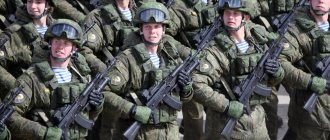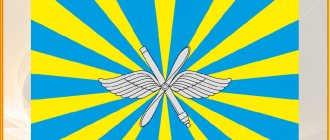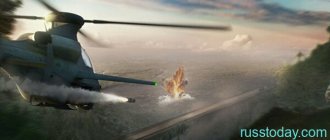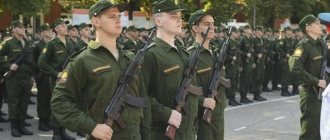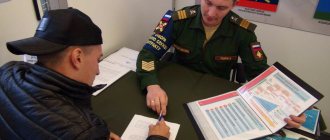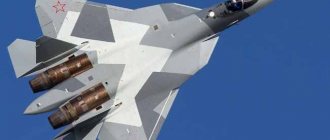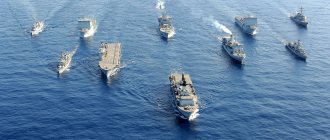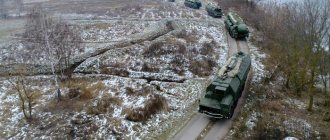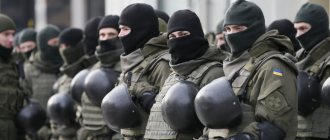There is no doubt that the modern Armed Forces of the Russian Federation are one of the most powerful military organizations in the world. According to various estimates, primarily by Western military analysts, the Russian Army ranks 2-3 in terms of overall indicators. So the size of the Russian army is more than 3,500,000 people. The assessment uses the number, quantity and quality of weapons, the military budget and a number of other indicators.
According to GLOBALFIREPOWER.COM, the Russian Army ranks 2nd out of 140 countries considered for the annual review. To determine the place in the table of ranks, the formula “PWRINDX” is used. For the Russian Federation it is 0.0791 . Thus, the calculation uses indicators such as numbers, number of weapons, population, length of borders, logistics capabilities and many others.
Let's talk in more detail about the Russian Armed Forces. Let's find out what the size of the Russian army is in 2022. What branches and types of troops does it consist of? Let's count the main types of weapons.
One of the strongest on the planet
Global Firepower has published data characterizing the combat power of the world's armies. In the Global Firepower Military Ranks 2022, the Russian one is in the top three, surrounded by the United States and the Middle Kingdom.
In terms of the number of military personnel, Russia is inferior to America and China. But it has the largest reserve.
The size of the army in the modern world is not particularly important. The main role is played by weapons, technical equipment and training of L.S.
— Durilov Alexander (@adurilov) May 10, 2017
Table 1. TOP 3 strongest armies in the world in terms of firepower
| US No. 1 | RF No. 2 | China No. 3 | |
| Tanks | 6 287 | 21 932 | 13 050 |
| Aviation | 13 398 | 4 078 | 3 187 |
| Aircraft carriers | 24 | 1 | 1 |
| Submarines | 68 | 56 | 76 |
| Nuclear warheads | 1 350 | 2 076 | 400 |
| Military budget, million $ | 716 | 44 | 224 |
Source: Global Firepower Military Ranks, September 2019, Stockholm International Peace Research Institute (SIPRI)
Armament and military equipment of the Russian Army.
According to rough estimates, the Russian armed forces have more than 4,000 aircraft and 1,500 helicopters. There is also information that Russia has 13,000 tanks , 27,000 armored fighting vehicles and almost 6,000 self-propelled artillery pieces. For the naval component, the following figures are given: 600 ships, including one aircraft carrier, 15 destroyers and 63 submarines. For the main indicators, see the table below.
| A country | Tanks | Aircraft | Helicopters | Armored cars | Ships | Submarines | Aircraft carriers |
| Russia | 13000 | 4144 | 1540 | 27000 | 600 | 63 | 1 |
| USA | 6100 | 13233 | 5436 | 40000 | 490 | 68 | 11 |
| China | 3205 | 3260 | 902 | 35000 | 777 | 79 | 2 |
Being conventionally the second most powerful armed forces in the world, the Russian Army has the largest stockpile of nuclear weapons. Almost half of the atomic warheads on Earth belong to our state. The numbers given are 6,257 warheads. You can read in more detail - Number of armies in the world in 2022: TOP-5.
Poplar is on duty.
Change in numbers
On January 28, 1918, the Council of People's Commissars adopted a decree on the organization of the Workers' and Peasants' Red Army. The number of the Red Army by September 1918 was already almost half a million people. And by the end of 1920 it increased to 5.5 million people. pic.twitter.com/58Jj22osnL
— Stalin — Center ☭ (@StalinCentr) January 28, 2020
Let's use information about the quantitative composition of the USSR Armed Forces from encyclopaedia-russia. During World War II, the country mobilized all its resources, putting more than 11 million people under arms. Despite the conflicts that flared up every now and then in the world (Korean War, Berlin, Caribbean), the Soviet state is heading towards reducing the army. Its population is 5.76 million people. in 1954 fell to 3.6 million in 1960.
Since the 1970s, the process changed direction, and in 1980, as the russian7 website reports with reference to materials from headquarters memos and military archives, “the number of military personnel in the Soviet army exceeded five million.”
Graph 1. Dynamics of the number of SA at the time of the collapse of the USSR. Source: compiled by the author according to encyclopaedia-russia
In 1991, the formerly united one was divided into 15 independent armies of the former sister republics. In Russia at the time of its formation there were 2,870 thousand people. After 1992, several rearmament programs were adopted: from the first, in November 1996, and subsequent ones, in 2002, 2006, 2010, to the new one in 2022.
But the size of the Russian army is determined by decrees of the country's president - the commander-in-chief of the armed forces. Let's turn to them.
Reference! The annual budget of the RF Armed Forces in 2022 was 3.287 trillion rubles. This is 5.4% of the country's total GDP. Source: Military Review
Military-administrative division of the Russian Federation
In accordance with Presidential Decree No. 1144 “On the military-administrative division of the Russian Federation” signed on September 20, 2010, all six existing military districts were abolished. The following four enlarged military districts were newly formed:
- The Western Military District includes the former Moscow and Leningrad military districts;
- The Central Military District includes the former Volga-Ural Military District and part of the Siberian Military District;
- The Eastern Military District includes part of the Siberian Military District and the former Far Eastern Military District;
- The Southern Military District was formed on the basis of the former North Caucasus Military District.
In wartime, on the basis of new military districts, joint strategic commands (USC) will be created, which will exercise operational leadership of diverse forces and means - ground forces, navies, and air forces.
Presidential decrees
By the time Yeltsin’s first agreement, dated 05/07/1992, on reforming the Armed Forces was signed, the number of military personnel, according to various estimates, reached 2.5–2.8 million people, excluding civilian personnel.
According to data from open sources, by 1994 the number of military personnel in Russia decreased to 2.1 million, by 1996 to 1.7 million (40% compared to 1992) (TASS).
Since 1996, the head of state, by his decrees, has established the number of armed forces (since 2005, including civilian personnel). Since 1997, 8 of them have been published.
Table 2. Staffing strength of the Armed Forces of the Russian Federation
| Signing date/effective from | Total, thousand people | Including military personnel |
| 07/16/1997 No. 725с/01/01/1999 | … | 1 200,0 |
| 03/24/2001 No. 337с | … | 1 000,0 |
| 11/28/2005 No. 1372с/01/01/2006 | 2 020,5 | 1 134,8 |
| 01.01.2008 № 1/01.01.2008 | 2 019,6 | 1 134,8 |
| 12/29/2008 No. 1878ss/01/01/2016 | 1 884,8 | 1 000,0 |
| 08.07.2016 № 329/01.01.2017 | 1 897,7 | 1 013,6 |
| as amended on March 28, 2017 No. 127/07/01/2017 | 1 903,1 | 1 013,6 |
| 17.11.2017 № 555/01.01.2018 | 1 902,8 | 1 013,6 |
Source: consultant
Mobilization reserve of Russia
There are no plans to completely abandon conscripts from military service. The military power of a state consists not only of fighters wearing shoulder straps. The mobilization potential of the country is no less important.
As sad as it may be, in the event of war, those who are in the ranks at the time of the start of active operations will be the first to be knocked out. They should be replaced by trained citizens who have completed military service school.
The need for mobilization resources of the Russian Federation by 2022 will be 450 thousand officers and 2.8 million soldiers and sergeants
Army structure
Organizationally, the RF Armed Forces consist of separate branches of the military: ground, naval and military space (created in 2015 at an Air Force base).
Source: militaryarms
There are also independent ones: the Airborne Forces, the Strategic Missile Forces, and special forces. As well as motorized rifle, called “mechanized infantry,” tank, air defense, missile and artillery. No one will undertake to name their exact number. Only approximate conclusions are drawn.
As of 2022, there are thousands of people in the army:
- land - 400 (according to militaryarms estimates - 300 thousand);
- air force – 150;
- navy - 150;
- military space – 120;
- Airborne Forces - 35.
Among the military people there are also representatives of the weaker sex.
According to OV-Business News, the number of women in the Russian army is now about 44.5 thousand people. And almost 315 thousand more are involved in one way or another in the work of the Ministry of Defense of the Russian Federation.
Source: militaryarms
Interesting statistics! How many female pilots are there in Russia?
Types of Armed Forces
The army includes 3 types of troops: ground forces, aerospace forces, and navy. Each consists of divisions with their own goals and objectives.
Ground troops
Conscripts most often end up in units related to the ground forces:
- motorized rifle;
- tank;
- rocket and artillery;
- Air defense.
Units are engaged in defense or offensive during an enemy attack on the territory of the country and act in a comprehensive manner. The ground forces also include engineering, railway troops and special forces units.
Motorized rifle units
This branch of the military is equipped with equipment, armored personnel carriers and infantry fighting vehicles, which helps infantry groups to move quickly. Together with tanks and artillery, young soldiers learn to hold occupied positions, carry out an offensive, breaking through enemy defenses. Encounter battles are organized by infantry units together with landing forces and army air forces.
Tank
The main striking force is tank formations. They are maneuverable and stable when nuclear strikes are carried out and weapons of mass destruction are used. During defense and attack, tanks support motorized rifle units and insure them.
Rocket and artillery
These types of troops were created to deliver a nuclear and missile strike to the enemy. Armed with howitzers, mortars, rocket and anti-tank artillery, they are capable of neutralizing enemy armed forces and suppressing them.
Air defense (air defense)
The troops are formed from reconnaissance, anti-aircraft missile, and radio engineering units. Their actions are aimed at identifying air attacks and neutralizing enemy actions. Military personnel are on combat duty in the territory, providing protection to their troops.
Reconnaissance formations detect enemy points, their location, and determine the number of enemy troops.
Engineering
Only specialists with engineering training are recruited into these formations. They will have to plan work to strengthen the territory, erect barriers, mine and clear the area, arrange crossings across water spaces, and perform camouflage.
Radiation, chemical, biological protection (RCBZ)
Everything related to detecting contamination of the area, camouflage, neutralizing contamination, and protecting combat units is carried out by these troops.
Connections
The purpose of these parts is to organize communication. It is necessary for leading troops during defensive and offensive actions. The work of signalmen is equipped with modern automated systems and command point facilities.
Signal troops are an important link in the functioning of the entire Russian Army
Aerospace Forces
The list of aviation branches consists of:
Daily routine of the military unit
- far;
- frontline;
- army;
- military transport.
There are formations of anti-aircraft missile and radio technical troops in the army, and special aviation units. Aviation is tasked with bombing enemy positions, transporting important cargo, weapons, and manpower. Space forces are called upon to identify threats from space and repel them. They launch vehicles, monitor satellites, and maintain their combat capability.
Navy
The tasks of submarine and surface forces, coastal troops, and naval aviation include protecting the territory of the Russian Federation located on the high seas. In peacetime, the forces of the Navy are aimed at searching and rescuing shipwrecked people. There are 5 flotillas located along the borders of the Russian state. Conscripts serve there for 2 years.
Surface forces
Fleet ships transport manpower and weapons. They cover the submarine forces. Their tasks include mining and demining of water areas.
Underwater
Nuclear-powered strategic and multi-purpose submarines carry out operations on:
- destruction of enemy military points on land and water;
- liquidation of sea vessels for various purposes;
- intelligence;
- landing troops on enemy territory;
- mining
Military service on underwater vessels is associated with difficulties and requires special knowledge and physical training.
Naval aviation
The actions of this branch of the Armed Forces are aimed at convoying ships, protecting them from attack from air and sea. Reconnaissance units help find the right direction for fleet ships.
Coastal parts
This type of military service consists of protecting naval bases. Military personnel need to cover their formations from the shore and parachute onto enemy territory.
Airborne Troops (VDV)
The best of the conscripts end up serving in the airborne troops, which are distinguished by a high level of combat training. The Airborne Forces are considered the backbone of the army's mobile forces and report directly to the Supreme Commander-in-Chief.
Strategic Missile Forces
These units serve to deter nuclear aggression and defeat enemy forces. The troops are armed with complexes that meet modern requirements. The created Topol M type weapons strengthen the country's military power.
Rear troops
The rear units supply the army. After all, military personnel need clothing, medications, food, and technical equipment.
Contract service
President Yeltsin announced that the army in the Russian Federation would completely switch to a contract basis. He named the deadline - 2000. But the default happened in 1998, and the plans had to be postponed. Gradual implementation began in 2004.
Nobody gives the final dates, but in 2015 there were 352 thousand contract soldiers, and for the first time their number exceeded the number of conscripts, in 2016 - 384 thousand people.
However, the target of 405 thousand military positions to be filled by contract servicemen for 2022, which was reported by Viktor Goremykin, head of the Main Personnel Directorate of the Ministry of Defense in an interview with Army Collection, was not achieved.
“Since 2012, the number of contract soldiers in the army has more than doubled and currently stands at 394 thousand people.”
Sergei Shoigu, Minister of Defense of the Russian Federation, March 2022
They fell a little short.
Chart 2. The ratio of those serving under a contract and conscripts, thousand people. Sources: Ministry of Defense, Krasnaya Zvezda
Material on topic! How to get a job in the Russian Guard: requirements for applicants.
According to a survey conducted by the Levada Center in the spring of 2022, as reported by RBC, when asked about their attitude towards conscription service, Russians responded:
- 60% – every real man should join the army;
- 24% is a debt that must be paid to the state;
- 12% – consider it a pointless and dangerous activity;
- 4% found it difficult to answer.
According to a FOM survey conducted in April 2022, respondents prefer the type of service:
- 31% – full transition to a contract;
- 17% – staffing with conscripts;
- 49% – mixed option.
The authorities are not talking about increasing the number of personnel in the Russian army. But Sergei Shoigu considers the task of gradually reducing and bringing the conscription contingent to the optimal size completed and admits that the most acceptable level has been achieved. The minister is confident that it will remain this way until about 2025. The government is planning to implement programs to increase the number of professional soldiers and sergeants in the Russian army. It will continue to grow to 475.6 thousand people.
Author: Demidova Marina. February 18, 2022.
Composition of troops in the military ID
You can determine where a reserve soldier served and for how long on his military ID. Persons acquire a military registration specialty when:
- serve on urgent conscription;
- graduate from a university faculty with a military department.
VUS numbers indicate where the recruit served. The numbers are arranged so that a specialist can use them to decipher suitability for service. You can find out in which units the citizen’s knowledge and skills were used. The letters indicate in which units they served. The letter A tells about the ground forces, the letter P for internal purposes, and the letter D for the landing forces.
There are cases when a specialty acquired in the army comes in handy in civilian life.
The structure of the army in Russia is such that recruits can choose the branch of the military for which they are suitable. Each branch of the Armed Forces has its own goals and objectives, which helps conscripts to be ready to defend their Fatherland in the future.
The composition of the Russian figure skating team at the 2022 Olympics: who will go to the Games in Beijing
Russia has the most lethal lineup for the Olympics in history. Let's figure out what to expect from our team at the Games.
Kamila Valieva
Kamila Valieva / Photo: © RIA Novosti / Alexander Vilf
European champion, Russian champion, world junior champion. All these titles in themselves sound deafening, but they don’t even half show the true power of Kamila Valieva. The 15-year-old figure skater is the current holder of three world records and, there is no doubt about it, the favorite for the Beijing Olympics. For Kamila Valieva not to win this Olympics, some kind of apocalypse must happen, and then against the backdrop of the skating lives of her main rivals - Alexandra Trusova and Anna Shcherbakova. The reserve in the second assessment allows Kamila to fall once and make a mistake on the jump once, but still remain first with an incredible amount of points and a large margin. At the European Championships in Tallinn, this is what happened - with a fall on the triple axel and an error on the cascade in the free program, Valieva scored a total of 259.06 points. The best results of Shcherbakova and Trusova in their careers at the moment are 240.92 and 241.02.
Valieva’s participation in the team tournament is still in question, but it will be absolutely justified if it is accepted, no matter how you look at it: if you consider that being a team player is a privilege for the best, and if you proceed from the strategy of selecting the most effective players. Valieva’s effectiveness is an axiom of figure skating that does not require proof.
Anna Shcherbakova
Anna Shcherbakova / Photo: © Jurij Kodrun – International Skating Union / Contributor / International Skating Union / Gettyimages.ru
If our federation needed a person capable of walking along a silk thread stretched over the Pacific Ocean, they could not have found anyone better than Anna Shcherbakova. As a three-time Russian champion, she definitely knows a lot about doing the impossible. As a world champion, Shcherbakova crushed this immense impossible to the size of a gold medal and hung it around her neck. It seems that there are no health conditions in which Anna has not had to skate, and at the same time she guarantees the quality of her performance in any condition. Even with just one quadruple jump (or without them at all in the worst scenario), Shcherbakova has such a set of triples with complex cascades that she is able to defeat quad and accelerator Trusova, Tuktamysheva with errors, as well as Japanese and Korean women.
Alexandra Trusova
Alexandra Trusova / Photo: © RIA Novosti / Alexander Vilf
It’s impossible to imagine the Olympics without her. Alexandra Trusova is a living embodiment of everything athletic, sporting and record-breaking that exists in the culture of the Olympic movement. If she manages to fulfill her dream of collecting five clean quadruple jumps on Beijing ice, she will become the first figure skater to do this in official competition. And then Sasha will outdo all the men singles athletes competing at the Games in terms of the cost of the ultra-c set. In the end, only pure Trusova can be able to win against pure Kamila Valieva, and this gives us at least some intrigue with the name of the future Olympic champion.
Adding salt to the already rich broth of this Olympic season is the fact that Trusova had to assemble quadruples from scratch twice. First, she showed them at open skates in Chelyabinsk, then she spent a long time without training with a broken foot, and by the time of the Russian Championship she began training the five-quad again. A unique athlete!
Mikhail Kolyada
Photo: © Dmitry Chelyapin / Match TV
Potentially, Mikhail Kolyada is our only hope for a medal in men's single skating. You can treat him as a phenomenon as ironically and distrustfully as you like, but international judges adore Kolyada and are ready to give him high marks even in not the most technically difficult performances.
In the context of the Olympics, the reasons for Mikhail’s withdrawal from the European Championship raise concerns - his coaches explain them with a “foot injury” without specifying details. How severe is the injury, will he be able to recover for the Games? There is not much time, but there are no options either. The Olympics are a tournament where superhumans ride with cracked bones, broken noses and concussions, because the next Olympics may simply not happen in their lives.
It is quite possible that the story of trauma will have a positive impact on Kolyada’s psyche. He had already won silver at the Russian Championship with a wild pain in his head due to an exacerbation of sinusitis, and never, perhaps, was he more collected than then. But it’s better that nothing hurts or interferes anymore - I want to see “The Nutcracker” and “The White Raven” in perfect performance.
Mikhail Kolyada and the team tournament is a topic worthy of many years of philosophical reflection. But for some reason there is a feeling that this time the federation will spare both Mikhail and the team and entrust the performance to someone else. And Mikhail will then be able to concentrate on the personal tournament, especially since it starts the very next day after the team.
Mark Kondratyuk
Mark Kondratyuk / Photo: © Jurij Kodrun – International Skating Union / Contributor / International Skating Union / Gettyimages.ru
As Alexey Mishin said, in principle, he rarely comments on the successes and failures of other people’s students, last season Mark Kondratyuk’s bronze medal at the debut Russian Championship was perceived by many as a curious accident. Someone died, but he was able to - there are such sudden flashes of glory in figure skating.
Then Mark suspiciously did it again - in the team tournament of Channel One he gave two super convincing performances. Why is it suspicious? Because for every singles skater who is able to perform the program cleanly more than three times, we happily hang a sign “the hope of Russia.” At first it’s just a plaque of honor, and then it’s a convenient target for throwing tomatoes at everyone after the first failure of “hope.” Someone had to break the bad pattern, and Mark did it.
He didn’t start the season very smoothly - there were problems with injuries - but he fulfilled his minimum task at the German Oberstdorf Cup: he defended Russia’s right to three Olympic quotas. And he went on, increasing the pace, at the end of the year he produced two fantastic performances at the national qualifying championship. And then I was able to do it again, winning gold at the European Championship in wrestling.
The thing is that Mark is unusually easy about his role on the ice. He prefers to ride and make the audience roar with delight than to die from responsibility and a sense of fear. Perhaps this quality is very useful for a team tournament - it would not be surprising if Kondratyuk was sent to skate both programs there.
Andrey Mozalev
Andrey Mozalev / Photo: © RIA Novosti / Alexander Vilf
The 18-year-old skater earned his right to go to the Olympics after twice beating fellow young contender Evgeniy Semenenko in the race. First, he was ahead at the Russian Championship (Mozalev was 3rd, Semenenko 4th), then at the European Championship, where Andrei went literally the day before the start, replacing Mikhail Kolyada, who dropped out due to injury.
The successful experience of last season with a trip to the World Championship and strong nerves spoke in Semenenko’s favor. In favor of Mozalev - twice confirmed superiority over his opponent. Most likely, we won’t see Andrei Mozalev on the team, and that will be right. But he will be able to show himself in an individual tournament - for a debutant a great chance to declare his future ambitions.
Victoria Sinitsina - Nikita Katsalapov
Photo: © Jurij Kodrun – International Skating Union / Contributor / Getty Images Sport / Gettyimages.ru
The most experienced and titled couple in our team. Russia's hope for gold in the most difficult fight with the French is Papadakis - Cizeron. At the same time, Victoria and Nikita’s only rival is always with them, and this is... Nikita’s back. If everything is okay with her, and we desperately hope so, Sinitsina and Katsalapov will dance with everyone. For this they have an ironic-sexy rhythm dance in funk style and a rolling Rachmaninov in the free program.
Vika and Nikita went to their first joint Olympics for 8 years through all the thorns that exist in this galaxy. It's time to collect the stars.
Alexandra Stepanova - Ivan Bukin
Photo: © Joosep Martinson – International Skating Union / Contributor / Getty Images Sport / Gettyimages.ru
It's hard to believe, but for public favorites Alexandra Stepanova and Ivan Bukin this will be the first Olympics. They have been at the top for a long time - since 2014, but they missed the Games in Pyeongchang due to a vague story with the non-invitation of the IOC partner. They were loved by the fans and were sometimes recognized or not recognized by the judges, but one can say unequivocally - Stepanova - Bukin is one of those couples that the federation could rely on at any moment. Almost no blunders have been noticed for them, including the most important starts, and when they are physically healthy, they always go on the ice ready and in shape. The couple also has their own personality, although throughout their career they had to remain a little in the shadow of the number one.
It will be difficult for Alexandra and Ivan to fight for medals in the individual tournament, and even dance experts will not be able to explain why. That is, they can, but all these explanations will revolve around “well, you all understand, it’s a turn, the North American duets are strong, but no one will give Russia two medals.”
But if the federation decides to spare Katsalapov’s back and makes a replacement in the dances in the team tournament, no one will cope with this task better than Stepanova - Bukin. And then they will have an Olympic medal.
Diana Davis - Gleb Smolkin
Photo: © Jurij Kodrun – International Skating Union / Contributor/ International Skating Union / Gettyimages.ru
Diana Davis and Gleb Smolkin became one of the most discussed sports units of the Russian pre-Olympic championship. In the absence of leaders Sinitsina and Katsalapov, they were able to take second place, which guaranteed them a trip to the European Championships and opened the door to Beijing for the Olympics. Someone even said that the couple was pumped up with points on purpose in preparation for participation in the team tournament, because Tutberidze’s daughter (Eteri Georgievna - Diana Davis’s mother) needs an Olympic medal.
The scores at the European Championships from international judges finally dotted the i’s. With maximum probability, we can assume that Davis and Smolkin will not have any teammate, at least in Beijing. They will not be able to get ahead of either the Canadians, the Americans, or the Italians, and they also risk losing even to a couple from Georgia. This would be an unacceptably low result for the team. Therefore, Diana and Gleb will go to gain experience and prove themselves to the judges in a personal tournament, and someone mature and deserved will perform on the team. If we consider Davis and Smolkin a couple of the future, then only in the sense of the future cycle.
Anastasia Mishina — Alexander Gallyamov
Photo: © Dmitry Chelyapin / Match TV
Mishina - Gallyamov have been demonstrating phenomenal results since the moment they decided to change their careers and moved from coaches Lyudmila and Nikolai Velikov to the group to Tamara Moskvina. They are stable, technically trained and psychologically stable, and they also look fantastic together. This is exactly what will be needed in the most dangerous battle of the Beijing Games - the sports pairs tournament. The home team's gold is at stake there, so Anastasia and Alexander will have a hard time.
However, so far they have never given any reason to doubt themselves. At 20 and 22 years old, Mishina - Gallyamov are already champions of Russia, Europe and the world, and it would be very nice to add Olympic gold to this set.
Alexandra Boykova - Dmitry Kozlovsky
Alexandra Boykova and Dmitry Kozlovsky / Photo: © Dmitry Chelyapin / Match TV
Boykova - Kozlovsky at this Olympics will be responsible for “Swan Lake” - what kind of Games would be without the eternal classics of Tchaikovsky, especially performed by classically trained St. Petersburg beauties. With the arrival of their closest rivals Anastasia Mishina and Alexander Gallyamov into the group, Alexandra and Dmitry had a hard time - it took time to adapt to the fact that they were no longer the only beloved “children” of Tamara Moskvina. But already at the Russian Championship one could see the old Boykova and Kozlovsky - confident, pure and daring.
After bronze at the European Championships, Sasha and Dima can approach the Games more charged than ever, especially if they are not allowed to compete in the team tournament. And then in the individual championship of sports pairs, everyone should be afraid - both the rivals from Russia and the Chinese Sui - Han.
Evgenia Tarasova - Vladimir Morozov
Photo: © REUTERS / Ints Kalnins
Tarasova - Morozov is the most experienced pair in the team. This will be their second Olympics and their second - perhaps last - chance at an individual Olympic medal. To achieve this goal, Evgenia and Vladimir tried to train in America with Marina Zueva, took on their older friend and two-time Olympic champion Maxim Trankov as their permanent mentor, and before the current season they even moved to the group of Eteri Tutberidze, who had never coached sports pairs before.
A large group of specialists is working with Evgenia and Vladimir, and their only real problem is psychology. Failures of lifts, mistakes on jumps and other “dirt” on elements come from this, and not from poor preparation or lack of training. If at the decisive moment Tarasova and Morozov do not flinch, they can take away from Beijing not only a personal abstract medal, but also gold. In addition, they are candidates for participation in the team tournament - they already have such experience, and successful ones.
Leaders in the preparation of army replenishment
Among the regions of Russia there is a certain competition in organizing the training of young people for military service and active interaction with the Armed Forces. According to the head of the Main Organizational and Mobilization Directorate of the Russian General Staff, Burdinsky E.V. in the lead:
- Republic of Tatarstan;
- Stavropol region;
- Tyva Republic;
- Republic of Crimea;
- Omsk region;
- Belgorod region;
- Voronezh region.

